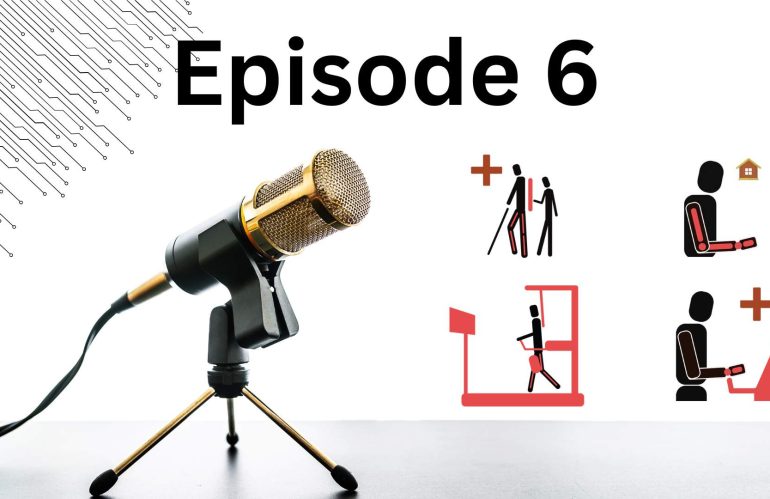In the 6th episode of the Exoskeletons and Wearable Robotics Podcast, we conclude our overview of the significant applications of exo technology. Medical wearables have been developing for decades, and there is no shortage of devices and uses to discuss. However, this is a very sensitive topic. On the one hand, we didn’t want to accidentally hype up the availability or the capabilities of assistive and physical rehabilitation devices or robotics. There are millions of individuals around the globe who suffer from one mobility impairment or another, and we did not leave them with a sense of false hope. Conversely, we didn’t want to sell short the life-changing opportunities this technological field represents. This episode drops simultaneously as the CYBATHLON that brings top-of-the-line, and sometimes experimental, mobility aids in friendly head-to-head competition, which is a lucky coincidence.
Watch Episode 6 on YouTube:
Or listen to it right here.
Episode 6 will also be available on all main podcasts and music apps, and the podcast has over 120 downloads already.
Episode 6 of the Exoskeletons and Wearable Robotics podcast is brought to you with the financial support of our Patreon subscribers:
Hosting the Exoskeleton Report with the associated editing software costs more than $4,000 annually. If you enjoy our content, please consider supporting us. Every Patreon membership is another vote of confidence in our mission to help humanity prosper in the face of proliferating automation and aging demographics. As a special thank you, paid subscribers will receive early access to the podcast episodes.
Summary of Episode 6:
(AI-Generated:) In episode six of the Exoskeletons and Wearable Robotics Podcast, hosts Bobby Marinov from Exoskeleton Report and Professor Tom Sugar from the Wearable Robotics Association discuss medical exoskeletons. They discuss various applications, ranging from mobility exoskeletons for people with spinal cord injuries to pediatric devices for children. Medical exoskeletons, one of the earliest application areas for exoskeleton technology, have generated significant interest due to their potential to enhance rehabilitation and assist with mobility.
The episode opens with a discussion on the most common medical exoskeletons, which assist individuals with spinal cord injuries in standing up and walking. These exoskeletons typically power the hip and knee joints, often requiring crutches or an external support system. Bobby and Tom highlight the benefits of repetitive task theory in these devices, emphasizing how repetitive motions can help retrain neural pathways and promote recovery. The exoskeletons help users perform the same motion repeatedly, significantly increasing the therapy dosage compared to traditional physical therapy.
They also touch on the evolution of these devices, including advancements in controllers that now allow exoskeletons to detect shifts in the user’s center of mass and respond accordingly. Tom mentions the self-balancing Wondercraft exoskeleton, which can operate without crutches, offering another level of independence to the users.
The hosts then discuss the distinction between medical exoskeletons used for assistive purposes versus those for rehabilitation. Assistive exoskeletons are designed for long-term use to compensate for mobility limitations. In contrast, rehabilitation exoskeletons are intended for temporary use to help users recover function after injuries, such as a stroke or traumatic brain injury. They note that rehabilitation exoskeletons can be used in clinical settings and at home, expanding access to therapy.
Bobby and Tom explore the challenges of pediatric exoskeletons explicitly designed for children and young adults. These devices are intended to support early mobilization, crucial for long-term benefits in children with mobility impairments. They discuss the additional regulatory and ethical considerations involved in designing and testing pediatric devices, making research in this area challenging but highly rewarding.
The hosts also briefly mention medical exoskeletons for upper body rehabilitation, such as shoulder and hand exoskeletons. These devices assist with repetitive tasks, such as reaching or grasping, essential for individuals recovering from a stroke or other upper body injuries. The use of gamification in these devices is highlighted to keep users engaged during therapy.
Tom shares insights into some of the more experimental approaches, such as using functional electrical stimulation in combination with exoskeletons to assist with conditions like foot drop. They also touch on fixed-frame exoskeletons used in clinical settings, which often include features like built-in cranes to assist users in getting into the device.
Throughout the discussion, Bobby and Tom emphasize the importance of balancing the potential benefits of medical exoskeletons with realistic expectations. While these devices have made significant advancements, they note that more research is needed to understand their long-term impact on rehabilitation and independence fully.
The episode concludes with Bobby and Tom expressing their hope to bring experts for future deep-dive episodes on specific applications of medical exoskeletons, particularly in areas like pediatric devices and stroke rehabilitation. They aim to provide a balanced perspective on the current state of medical exoskeletons, recognizing their promise and limitations.
A version of this article was originally published on the Exoskeleton Report website.
